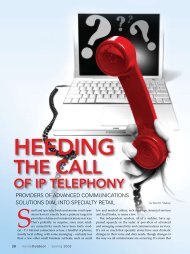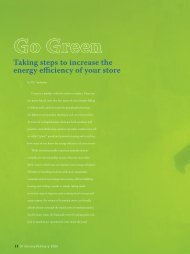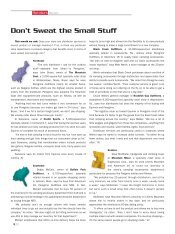CLOUD COMPUTING AND THE FUTURE OF RETAIL
CLOUD COMPUTING AND THE FUTURE OF RETAIL
CLOUD COMPUTING AND THE FUTURE OF RETAIL
Create successful ePaper yourself
Turn your PDF publications into a flip-book with our unique Google optimized e-Paper software.
Ongoing concerns about solution<br />
vendor or service provider stability<br />
and longevity<br />
We don’t like sharing our<br />
innovations with outsiders<br />
Source: RSR Research<br />
18%<br />
5%<br />
16%<br />
9%<br />
0 10 20 30 40 50 60 70 80<br />
ations<br />
How much do each of the following factors influence how<br />
your company’s technology portfolio will change?<br />
We want to spend less time on “catch up”<br />
investments in IT, and spend more time<br />
differentiating with IT-enabled capabilities<br />
52%<br />
48%<br />
We need to shorten the lead time<br />
to customer demand fulfillment<br />
47%<br />
48%<br />
and manages the solutions, as well<br />
Rapid<br />
as<br />
consumer<br />
cloud<br />
adoption<br />
or engage<br />
of new<br />
a third-party provider at Retail Systems 47%<br />
technologies such as “smart mobile”,<br />
Research, with the<br />
the user’s experience with “social them. media”, Cloud etc. is forcing to host us and to “go manage faster” it – either on site or user having 34% no knowledge or concern of<br />
services ranging from raw infrastructure off. A private cloud provides restricted where any individual piece resides.<br />
We need to overcome an ingrained “not<br />
41%<br />
to complete business processes invented (email, here” attitude access and take to the advantage computing capabilities and “This is different than a simple hosted<br />
of what’s commercially available<br />
31%<br />
accounting, CRM, scheduling, forecasting,<br />
resources to be shared only by employ-<br />
application accessed remotely,” says RSR.<br />
as examples) are purchased and ees or external partners, such as distrib-<br />
“Parts could well reside on a local device.<br />
We need to reduce ongoing maintenance<br />
41%<br />
accessed through Web interfaces. costs associated with utors owning and manufacturers.<br />
solutions<br />
It’s completely location 45% agnostic.”<br />
That might sound a lot like how<br />
Most retailer deployments up to this<br />
we’ve come to know and use the Internet,<br />
point, suggest findings from<br />
Winners<br />
Accenture, involve<br />
OthersCut and Paste<br />
you might say. In many ways, this<br />
is precisely how routed networks based<br />
on Internet protocol (IP) work, and the<br />
pervasiveness of high-speed access is<br />
largely what makes cloud computing so<br />
powerful. But before you start cringing<br />
over the idea of placing your customer<br />
data or communications services on the<br />
either a private cloud or some type<br />
of Source: “hybrid RSR model,” Researchthe managed combination<br />
of both private and public clouds.<br />
“So, for example, low level data and<br />
access may well be suitable to go onto a<br />
public cloud infrastructure service with<br />
simple password access, whereas ultra<br />
The primary promises of the cloud<br />
include enhanced flexibility and speed<br />
at significantly lower costs, and few<br />
vertical markets need to drive such advantages<br />
out of their IT infrastructures<br />
during the next several years more than<br />
retail/wholesale.<br />
wild and open Internet, it’s first important<br />
to have an understanding of the<br />
differences between the “public cloud”<br />
The shopper is better connected to consumer information<br />
than store associates.<br />
(Percentage of responding retail employees)<br />
and a “private cloud.”<br />
According to executives at IBM, the<br />
Completely<br />
Agree<br />
Neutral Disagree Completely<br />
Agree<br />
Somewhat<br />
Somewhat Disagree<br />
infrastructure in a public cloud is owned<br />
and managed by an organization selling<br />
cloud services and is made available to<br />
the general public. In this model, computing<br />
capabilities typically are accessed<br />
17% 37.5% 26.1% 15.3% 4.1%<br />
by multiple subscribing clients on a flexible,<br />
pay-per-use basis.<br />
Most people associate the public<br />
cloud with “community-based” offerings<br />
0%<br />
Source: Motorola Solutions<br />
50% 100%<br />
accessed over the public Internet,<br />
such as Google Apps, explains Joe<br />
Corvaia, vice president of solution<br />
engineering at cloud services provider<br />
Broadview Networks.<br />
secure data may require dedicated secure<br />
servers housed in ultra-secure data centers<br />
with strong authentication required<br />
for access,” explain Accenture analysts.<br />
Cloud computing also differs somewhat<br />
For starters, the retail industry<br />
doesn’t like to spend a lot on technology.<br />
Retail IT operating budgets, as a percentage<br />
of revenue, are typically among<br />
the lowest of all the major industries,<br />
from for the Using purely the “centralized Cloud com-<br />
The infrastructure in a private Initial cloud, Opportunities<br />
and we don’t expect that many retail<br />
on the other hand, is operated solely puting” model in that pieces and parts CFOs are anxious to shake this dubious<br />
distinction. By moving IT resources<br />
for a particular user organization. Easy This of an application and its associated data<br />
New Busin<br />
organization can either own the private can reside anywhere, explain analysts to the cloud, retail IT departments<br />
•<br />
can<br />
Provide IT support fo<br />
Business Continuity (storage)<br />
• Extensive storage<br />
• Back up & recovery<br />
Spring 2011 | InsideOutdoor | 15<br />
Batch and data intensi<br />
• One-off applications that don’t r
















